#gets the eyes and the mouthparts
Explore tagged Tumblr posts
Note
i am like a fly that wont leave you alone and once you think I'm gone I come right back and no matter what I'm always watching
OowoO U u u U
I know that's a spider but I don't know how to make a fly-
Splendid.
2 notes
·
View notes
Text
They’ll eat what?
A Telmurian is walking around the promenade on the station, talking to their family on their pad.
What was that? Your signal is pretty weak. Oh! Yes, they have humans here.
I know. Their planet has a really big moon, they won’t stop telling everyone they meet. Yes, they told me about it at least three times. I saw the photos, it’s pretty big I guess.
Yes, they’re strong. I remember the time that human from the helm picked up two Sefigans and carried them around on his arms. I didn’t tell her, but I was impressed. Why didn’t I tell her? I don’t know.
They also have odd thought processes. Remember that story about the one that learned that the water filters were the same as the outer compensator on the FlashWarp drive? They still teach us to check other parts for commonalities like that. The Sefigans are building a whole reference of parts that can be exchanged for other parts.
They walk around, oblivious to everyone else on the promenade. A Gren glares at them, and clacks their mouthparts irritatedly. They are speaking loudly. They walk on, oblivious to the disruption they are causing.
I didn’t call you to talk about any of that stuff.
I just learned about their ‘food.’
Did you know they don’t have a specific food? They don’t have one or two or even three items that they consider food, they have hundreds.
Maybe even thousands.
They stop and stare out a window and are silent for a few moments.
Not only that, but they combine them in so many different ways. Even wilder, they have modifiers to their food. Can you believe it? They have things that aren’t technically food that they add to food to make it ‘taste’ different. They’re called spices or seasonings.
I know! Have you ever heard of such a thing?
They have this thing called ‘taste.’ It’s a whole sense for them! It’s what enables them to try and test foods and discover ones they like and reject ones they don’t like.
I have a hard time with it, to be honest. Imagine, food you don’t like. It’s food right? By its very definition it’s something you consume to survive.
They clack their wing covers together, like a sigh. A Sefigan sitting at a cafe near them makes a gesture, like they’re trying to shoo them away.
Not for the humans I guess. They have whole careers, whole philosophies, maybe even whole religions about food and its preperation.
I read about the first time some humans came onboard a Coalition ship. They asked where the kitchen was and when we said “the what” it was like you unplugged them. They just stood there with their mouths full of their scary sharp teeth open in surprise.
I imagine we had a similar face the first time they showed us a kitchen. Imagine, a whole room, a whole part of the ship that was turned over to their pursuit of food.
That’s another thing! They can get bored of food. Whoever heard of such a thing. It’s food! You eat it, you feel full, you continue with your day. That’s like… like being bored of breathing.
Have I tried any of it? I mean, so much of it is straight up poisonous to us. No, you’re right, some of it isn’t.
All right fine. Yes. I tried one. There was this one, it was something they called a cookie. It was made of something like ten ingredients all in very precise measurements, then mixed together and shaped into balls and cooked at a high temperature. How did they ever come up with that?
The cookie? I don’t know, it was fine I guess. I didn’t get sick. I guess I can’t taste like they can it wasn’t much of anything, just food. I didn’t want to hurt their feelings so I said I liked it. They gave me four more! I didn’t know what to do with them. They’re still in my room.
Okay, yes, I love you too. Tell the rest of the crèche I said good evening.
They disconnect the call and look up. There’s a group of humans sitting down at a human style cafe eating. One of them looks up at them. Their large wet eyes seem impossibly deep. In the corner of them, wetness wells.
“You didn’t like the cookies?”
#writing#humans are space orcs#sci fi writing#humans are deathworlders#humans and aliens#jpitha#humans are space australians#humans are space oddities#humans are space capybaras
1K notes
·
View notes
Text
ok sure ill post the Weird Bug Layers too, weirdgirl jumpscare under cut


she gets progressively More Buggy the more stressed she gets, so the second image is Full Bugmode (minus the extra bug limbs, she gets those too)

i think i finally settled on a hairstyle for vivyin even if its still not quite as messy as i was picturing but itll do
full-time forensic pathologist, part-time cosplayer, all-time very exhausted centipede
#raidiculous artings#vivyin kafkah#those mandibles are gonna be a bitch to sprite when i get around to making them god knows when RIP#mandibles? pedipalps? they function more like a spider's mouthparts in that they can move around and w/e#idk how that mouth emotes but it does. tho she loses the capacity for speech the more the curse kicks in#also ignore the fact her freckles disappear i accidentally merged that layer onto her regular eye layer RIP
5 notes
·
View notes
Text
Round 2 - Arthropoda - Malacostraca




(Sources - 1, 2, 3, 4)
Malacostraca is the second largest class of crustaceans, and what most people picture when they hear the word crustacean! It contains over 40,000 species separated into 17 orders: Leptostraca, Stomatopoda (“Mantis Shrimp”), Decapoda (“Crabs”, “Lobsters”, “Crayfish”, “Shrimp”, and “Prawns”), Euphausiacea (“Krill”), Thermosbaenacea, Mysida (“Opossum Shrimp”), Stygiomysida, Lophogastrida, Spelaeogriphacea, Mictacea, Bochusacea, Cumacea (“Hooded/Comma Shrimp”), Tanaidacea, Amphipoda, Isopoda, Anaspidacea, and Bathynellacea. Many are scavengers, some are predators, some are herbivores, some are filter feeders, and some are parasites.
Malacostracans live worldwide, in marine, freshwater, and terrestrial environments, and have a large diversity of body forms. They are united by their segmentation of 20-21 body segments divided into a 5-segmented head, an 8-segmented thorax, and a 6-segmented abdomen with a telson, except in Leptostraca which has 7 abdominal segments. They have a pair of jointed appendages on each abdominal segment, though some groups have lost them secondarily. In some, three thoracic segments may be fused with the head to form a cephalothorax, the associated legs becoming maxillipeds. They have two pairs of antennae, which often branch into two parts. Their mouthparts have a pair of mandibles, maxillules, and maxillae. Many taxa have compound eyes on moveable stalks. Some have a carapace which covers the head, part or all of the thorax and some of the abdomen. The carapace may be fused with some of the thoraacic segments or hinged with two parts. This is one of the most diverse classes in the animal kingdom, and their anatomy and behavior would be hard to summarize further in just one paragraph!
The oldest malacostracans are the Leptostracans, which first appeared as fossils from the Cambrian period.

Propaganda under the cut:
“Carcinisation” has become a meme meaning “everything becomes crab”, but it actually only refers to the phenomenon of decapods convergently evolving crab-like anatomy. The Infraorder Brachyura contains the “True Crabs”, but at least 5 groups of unrelated decapods have evolved similar anatomy: a flat and broad cephalothorax.
Stomatopods (“Mantis Shrimp”) are known for their excellent color vision, but they probably can not actually see “shrimp colors.” They can see ultraviolet and polarized light, but their excess of photoreceptor cells actually lets them process their environment faster than we can, rather than differentiate between a multitude of different colors. This allows them to have quick reaction times, either to escape predators, fight or flee from rivals, or strike at their prey with amazing speed.
Malacostraca contains the largest living arthropods: the Japanese Spider Crab (Macrocheira kaempferi) with a legspan of up to 4 metres (13 ft) long, and the American Lobster (Homarus americanus), which can get up to 20 kilograms (44 lb).
Many species of malacostracans are commonly kept as pets, including crabs, crayfish, shrimp, mantis shrimp, and isopods.
Cute creb eat a cherry:

105 notes
·
View notes
Text
Secondhand Solutions
Mur gave me a smug look, curling and uncurling one tentacle like a yo-yo. “Told you it was a waste of credits,” he said.
I sighed. “If those human ships were here, it wouldn’t be. This stuff is prime Earth nostalgia.” The small pile of items on the hoversled had seemed so full of promise when I’d bought it at our last stop: cat posters, harmonicas, and a dozen packs of googly eyes.
“Pity we’re far from Earth,” Mur said.
“Yeah,” I agreed, eyeing the locals of this alien marketplace. Lots of scales and exoskeletons. Not many hands that would appreciate the softness of a cat’s fur, and very few mouthparts that would be able to do much with a harmonica. The merchant I’d gotten the stuff from had been a Heatseeker all too happy to unload her stock of cut-rate human nonsense. These folks would likely have similar opinions. I said, “At least it doesn’t expire.”
Mur straightened the individually-boxed harmonicas. “And it shouldn’t take up too much space in your quarters until we meet up with more humans eventually. The captain won’t want to hang around here waiting for them to show up.”
“True,” I admitted. It was gossip from our last stop that had told me they’d be here now. I should have known better than to trust it.
“Well, back to the ship,” Mur announced. “Maybe you can cheer yourself up by decorating your quarters with eyeballs.”
I had to smile at that. “Maybe.” He was already walking back to where we’d parked, on the far side of an over-cultivated garden area. I towed the hoversled after him.
Then I caught sight of some locals who’d run afoul of multiple birdlike beasties, and an idea started to form.
The locals, a half-dozen Heatseekers whose scales ranged from red to pale yellow, were trying to eat a nice lunch at the dining section of the garden. The squawking bird-things, which were half-lizardy with speckled brown feathers and wide beaks, had apparently claimed the bushes for their own. They were contesting this claim by spitting at the Heatseekers every time their backs were turned. These looked like pretty gross spitballs, impressive for birds.
It occurred to me that I’d seen those feathery characters all over the place here. A look behind confirmed it; they lurked in nearly every tree I could see. And judging by the way the locals were abandoning this picnic table, they were a known hazard.
They still only spat at fleeing enemies, hiding or freezing in place when pinned by eye contact.
And that was my idea. “Hey Mur,” I said. “I’ll bet you one shanty sung on a table that I can sell some of these googly eyes right now.”
He stopped and looked around, full of skepticism. “To who?”
“Do you take the bet?”
“Ah, sure. There’s no way anyone here is interested.”
“You say that now,” I said, grabbing a pack and waving down one of the hurrying locals. “But you don’t know how we deal with tigers and magpies.”
“With what?”
I didn’t answer, busy as I was explaining to the local that the false eyes were adhesive, and would give the impression of eye contact from both directions. They were just as interested as I’d thought they’d be.
After a demonstration, during which I strolled through the picnic area and didn’t get a single spitball on me, the birds were unsettled and the locals were more than happy to buy everything I had.
This was a new colony town, you see, and no one had come up with a good solution for the annoying fauna that came with the territory. But these folks were prepared to make everyone’s day.
They certainly made mine. That was five times as much as I’d paid for the stuff in the first place. And they didn’t even want the posters and harmonicas.
I waved goodbye, but they weren’t paying attention, so I turned my grin on Mur instead. He had draped a tentacle around his pointy squid head in exasperation.
“I knew I shouldn’t have taken the bet,” he declared. “But I was so sure it was pointless.”
“And I am sure that whichever song you choose to regale us with at dinnertime will be delightful,” I said, tugging the hovercart around the bushes. The birds watched me carefully, noting the eyes still stuck to my hair, and leaving us both alone. “If it’s a song I know, maybe I can play a backup melody with a harmonica.”
~~~
The ongoing backstory adventures of the main character from this book. More to come! And I am currently drafting a sequel!
#my writing#this one's relatively short so I'm going without the read-more#The Token Human#humans are weird#haso#hfy#eiad#humans are space orcs#googly eyes#I do enjoy some good be-googling#just made up that word; like bedazzled#it may not catch on#but that's okay#I'm still having fun
220 notes
·
View notes
Text
REVIEWING THIS WHOLE BAG OF RUBBER BUGS:
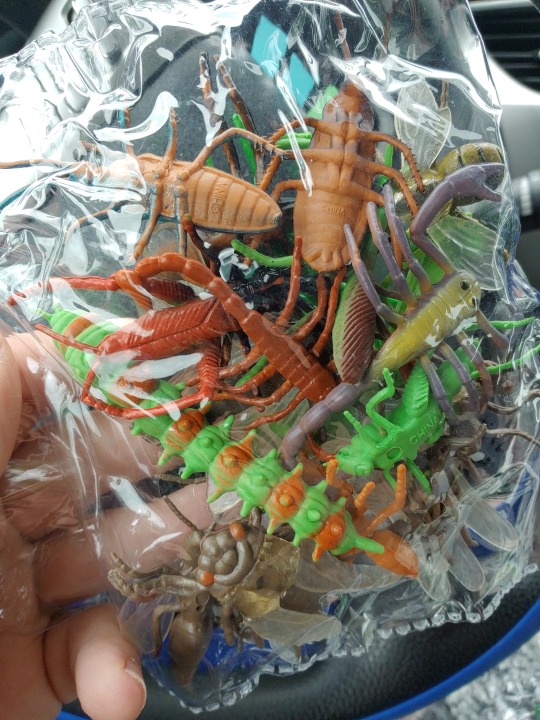
I mentioned recently that bags of cheap rubber bugs are harder to come by in real stores, but that there are a few options for them online. I just received this set from Aliexpress that’s currently only $4 with free shipping, you might even find the same set cheaper since there’s multiple listings for it, but I can verify this source is using an accurate photo and I am now going to REVIEW THEM:

SPIDER: obligatory, all-purpose spider, ambiguous species, noodly legs, minimal paint application, 3/5
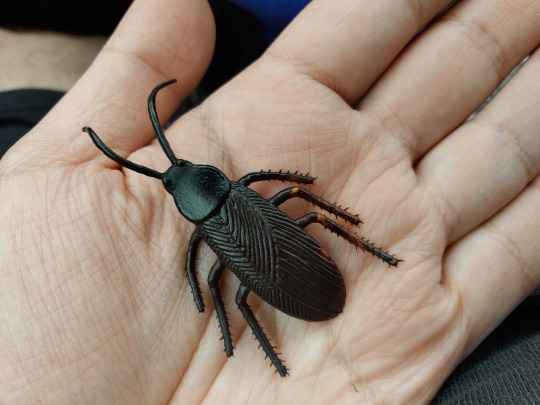
COCKROACH: nice silky black coloration on the back, tan on the underside, rather haphazard leg pose, I like it but in terms of objective quality it’s unfortunately a 2/5 compared to other fake roaches and even to other bugs in this set.
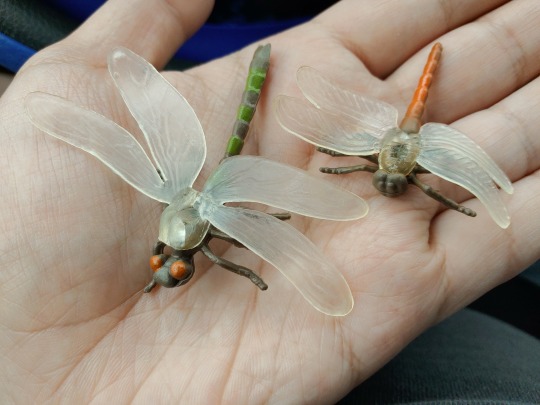
DRAGONFLIES: so this set is definitely pieced together from what were once multiple different rubber bug sets, but I can also confirm that you always get the same selection I’m reviewing, which includes several redundancies. You get both a large and small dragonfly with entirely different sculpts, the smaller one more accurately sculpted but not as dynamically painted! Both I’d give a 3/5, adequate dragonflies
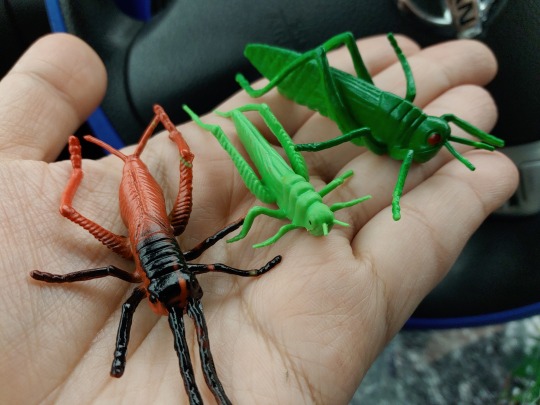
ORTHOPTERA: you get a cricket AND two different styles of grasshopper! The big, detailed black and red cricket is crudely painted but very unique, 3.5/5. The small grasshopper is cute and inoffensive, barely painted, 3/5. The large grasshopper is a 4/5 for me because while I’ve seen plenty like it, it has a really nice gradient from lime green to a darker grassier green that I just find very pleasant.
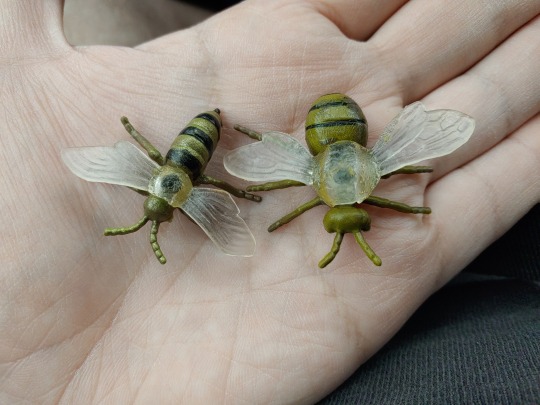
BEES: two very differently sculpted bees, and they both use a sparkly metallic gold with black stripes. Both deserve a 4/5.
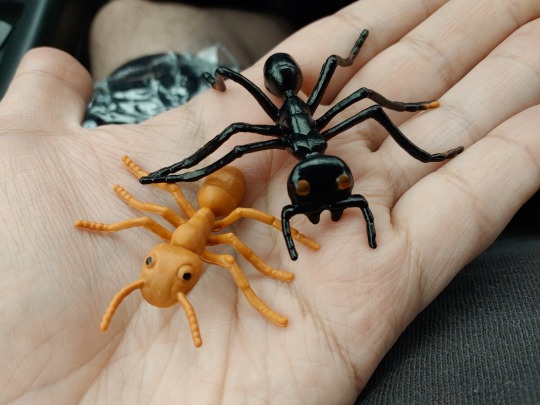
ANTS: collectively I’m gonna say these are a 3.5/5, on their own very plain but I like that together you have a dull yellow-tan ant with comical googly eyes and a bigger, more ominous shiny black ant with spooky red eyes. I like that the black ant is also tied with a couple others as the largest bug in the set. It’s actually only slightly larger than the real life Giant Amazonian ant, Dinoponera, which is also entirely black.

MANTIDS: excellent choice for another double bug, I like the simple cheapness of the little one with its awkwardly sculpted forelegs but to fair it’s a 2/5 compared to the 4/5 of the larger, red-eyed mantis which has more of that “sparkly” paint style!
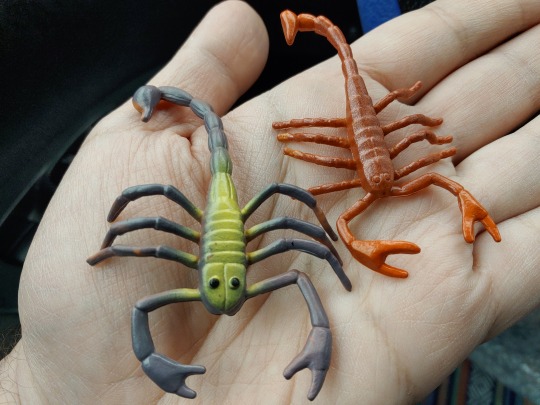
SCORPIONS: the only other arachnids in the set, and it’s amazing they included two different scorpions but only one spider. Trust me when I say that’s the most radical maverick decision a rubber bug set has ever made in the history of mankind. The small red scorpion is alright, a 3 I guess. The larger one has only six legs which is not accurate (the claws of a scorpion are modified mouthparts, not legs!) but I can’t look at its little black eyes and not want to cry so 5/5 actually.
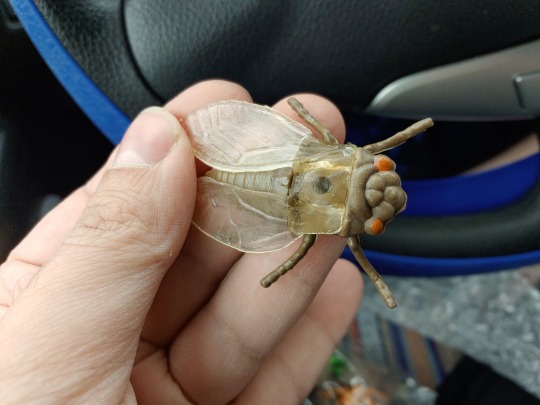
CICADA: not terribly common in these! Charming, chunky brown cicada, though the thorax piece is so transparent you can always see the hole it plugs into. At one time, this sculpt may have been part of a higher quality set that actually painted over this design flaw. 4/5 regardless.
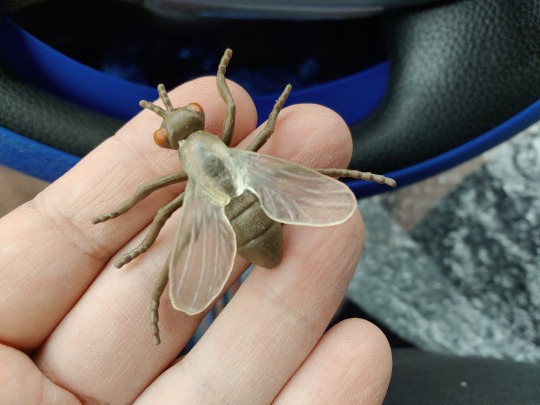
FLY: there’s a pattern here in which almost every flying insect in the set has a gold-brown base, which I’m not a big fan of. Sadly I’m overall neutral on this fly, normally my favorite of all the basic insects, perhaps because it looks just as much like some sort of wasp. It’s definitely a fly due to having only one pair of wings, and plenty of flies look exactly like this, but I’d just be a bigger fan if it was a chunkier, larger-eyed blowfly or horsefly. 2.5/5
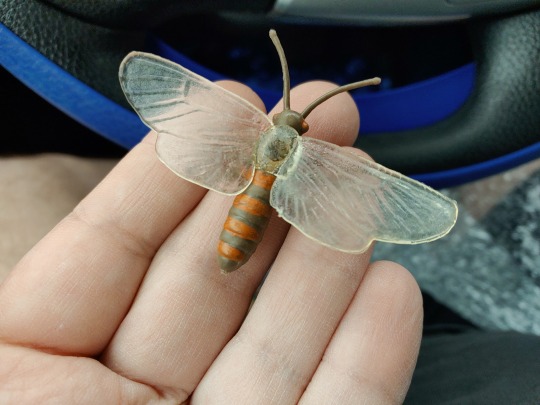
UNKNOWN: there are actually several insects this could possibly represent including a few Lepidoptera and Hymenoptera, but the one insect it most closely resembles is an adult caddisfly. I like it, but it’s difficult to fairly judge it with no certain identification so 3/5 has to do.

HAWKMOTH: stellar choice! I’ve seen only one cheap-grade plastic hawkmoth in my whole life, actually! Several hawkmoths are even clear-winged, though those usually still have dark markings around the wing edges. Would’ve been more accurate to some real species if they just cast the wings in a solid color, but that’s a trivial criticism. 5/5

WASP: the wasp is SO good. The paint on this one is skewed funny but that’s fine, the green of the abdomen pops really well and I love the grouchy red eyes. 5/5

CATERPILLAR: larvae are so rarely included in these, and when they are, they’re often an incredibly plain segmented tube that doesn’t look like anything in particular, or a recolor of a generic caterpillar I’ve seen several times before. This caterpillar sculpt is actually new to me and nicely shaped, with a tapering body and accurate limbs. It is however a rather stiff hunk of plastic, not as rubbery as the others, and honestly this is the one you would want rubberiest! Still a 5/5 for its inclusion at all.
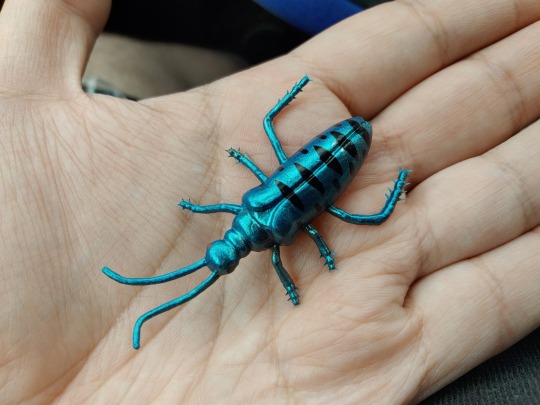
BEETLE: beetles are the most abundant, diverse insect group and the most common rubber bug toy after spiders, so it’s another bold move that they include only one in this whole set and it isn’t even one of the more recognizable, more famous beetles. On its own merits as just a rubber beetle it’s a 3/5, but its metallic blue stands out so nicely in this set, and the sculpt appears to be some sort of blister beetle, a rare choice and a very cool (but dangerous! Don’t touch them!!!) insect group so 5/5
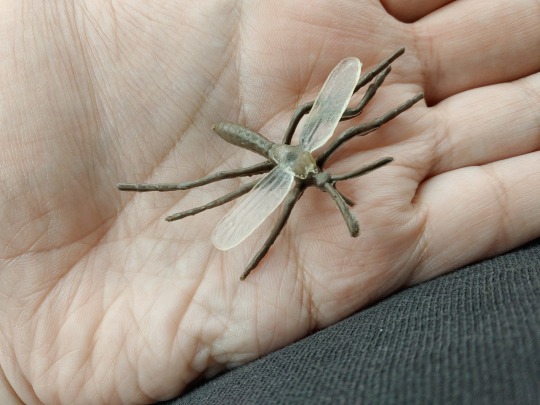
MOSQUITO: mosquitoes are another of my favorite animal groups, and as one of the world’s most abundant, most recognized, most controversial insects you’d think they’d be a standard bug toy already, but this is only the third plastic mosquito design I’ve ever seen in my entire long life! It’s brown, unpainted, dinky and bent funny. 10/5
835 notes
·
View notes
Text
Making Better State Insects
So at some point I stumbled across a list of State Insects. Honestly I wasn't even aware states had "state insects", but as I looked down the list my disappointment grew. A vast majority of states had selected the European honeybee (which is not even native) as their state insect, with monarch butterflies and ladybugs being the two runner ups. I thought this was a damn shame because there's so many interesting insects in the US, so I'm making a better official new list of state insects.
For this list my criteria are:
Insect must be native to the state
No repeats
Insect must be easily observable to the naked eye
I also had general guidelines of picking insects that were relatively common (based on inaturalist heat maps of observation) and picking insects that were cool or interesting. Some of these insects I picked because I thought they were important parts of the areas culture and experience (lovebugs, toebiters, and periodical cicadas) and some insects I picked just to raise awareness that they exist in the US.
I also don't think I gave anyone huge L's, no mosquitoes, louses, cockroaches, ect, because my goal of this list is to get people interested in their native insects and I want it to be fun to find and observe your state insect.
Also some states get gold stars for picking state insects that already meet these criteria and are cool so they get to keep theirs. Some states also have "state butterflies" or "state agricultural insect" which for this list I'm ignoring, you can keep those I'm just focused on state insects. Slight disclaimer also, I've only ever lived in California, Nevada, Oregon, Washington, and South Carolina, and all these states are keeping their original state insect. So all the insects I'm choosing are for states I haven't lived in. Also I'm not including photos in this post just for my own sanity.
List under the cut!
Alabama
Old: Monarch Butterfly
New: Giant Leaf-footed Bug (Acanthocephala declivis)
Leaf-footed bugs are cute, they're big, they're stanced up, the males have big back legs, you've probably seen them. Being true bugs they have piercing mouthparts and suck plant juices.
Alaska
Four-spot Skimmer (Libellula quadrimaculata)
Alaska gets to keep their old state insect, it's a cool dragonfly and apparently was partially chosen to honor bush pilots who fly to deliver supplies in the Alaskan wilderness, so really cool!
Arizona
Two-tailed swallowtail butterfly (Papilio multicaudata)
Arizona also gets to keep their state insect. Kind of a shame because Arizona has a lot of cool species, but it did meet my requirements and they get points for choosing a different kind of butterfly.
Arkansas
Old: European honeybee
New: North American Wheel Bug (Arilus cristatus)
One of the largest assassin bugs in the US, these guys are appreciated by gardeners for their environmentally friendly pest control. They also look badass.
California
California Dogface Butterfly (Zerene eurydice)
Endemic to California and on a stamp! Again, kind of a shame because there's a lot of cool insects in California, but I respect this choice, especially since California was the first state to designate a state insect (1929).
Colorado
Colorado Hairstreak Butterfly (Hypaurotis crysalus)
Same deal as California, the state's name is in the common name, unique butterfly found in the four corners region. Just get a stamp or something soon!
Connecticut
Old: European Praying Mantis
New: Cecropia Moth (Hyalophora cecropia)
You picked a state insect no one else had but went with a nonnative mantis? Here's an insect that'll make you stand out and it's a native species. Lesser known than some of the other giant silk moths, the Cecropia moth is the largest native moth and has some truly stunning colors.
Delaware
Old: Convergent Ladybeetle
New: Periodical Cicada (Magicicada septendecim)
Cicada's had to be somewhere on this list and Delaware was one of the main hotspots for brood X, one of the largest broods of the multiple staggered brood cycles. Hey, they have a lot of history in America. Accounts go back as early as 1733, with Thomas Jefferson and Benjamin Franklin making a note of them.
District of Columbia
Old: None
New: Monarch Butterfly (Danaus plexippus)
The Entomological Society of America is trying to get the Monarch Butterfly added as our national insect, so I think that's reason enough to let DOC claim it.
Florida
Zebra Butterfly (Heliconius charithonia)
Florida gets to keep their state butterfly, but the populations that have existed in Florida are in steep decline. Ideally I would want being the official state insect to come with some protections, hopefully people can get invested in reintroducing them.
Georgia
Old: European Honeybee
New: Horned Passalus Beetle (Odontotaenius disjunctus)
Also called bess beetles or patent-leather beetles, these cute guys are important for forest systems because they eat decaying wood, helping to break down felled trees. They're cute beetles that squeak when disturbed.
Hawaii
Kamehameha Butterfly (Vanessa tameamea)
An endemic Hawaiian butterfly named after a ruling dynasty of Hawaii. Their population is under threat, as with a lot of native Hawaiian species, so I think this is a good state insect to build protections and activism around.
Idaho
Old: Monarch Butterfly
New: Ice Crawler (Grylloblatta sp. "Polaris Peak")
Look Idaho, I have to admit that even though I've traveled extensively through WA, OR, CA, and NV I've never stepped foot in Idaho and I don't intend to. Your state exists in a weird liminal zone, not really the pacific northwest but not really whatever Montana is either. Your state isn't even all in one time zone. So look, I really wanted ice crawlers to be on this list, but they're exclusively found on mountains in the pacific northwest and Sierra Nevadas. Normally I would've given them to Washington or Oregon, but those states already have state insects that work for them. So your state gets ice crawlers, and they do exist in Idaho in the panhandle. It's not an L, ice crawlers are amazing extremophiles that crawl over snow in high elevation mountain peaks. They exist in their own unique order and theres only one genus in the US, with different species being region locked, sometimes onto specific mountains. Their thermoregulation is so delicate, the warmth of someones hand holding them causes them to over heat and die. They're cool, unique, and weird, and let's face it so is your state. At least I didn't take a cop out by picking the potato bug.
Illinois
Old: Monarch Butterfly
New: Red-banded Leafhopper (Graphocephala coccinea)
Leafhopper done Chicago style.
Indiana
Old: Say's Firefly
New: Common True Katydid (Pterophylla camellifolia)
I wanted to give you Say's Firefly. I really did. But when I looked on Inaturalist not A SINGLE OBSERVATION was listed for the species in Indiana. I'm even going to post pictures.
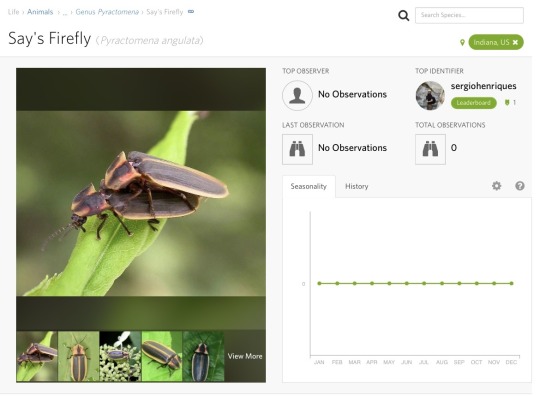

So even though this is extremely funny I'm giving your state the Common True Katydid instead. Large, loud, and easy to spot, these guys can frequently be heard chirping in trees. Not only do different populations have different rates of chirp, but the rate of chirp is also so predictably dependent on temperature that you could make an equation to tell the temperature based on chirp rate.
Iowa
Old: None
New: Westfall's Snaketail (Ophiogomphus westfalli)
Really cool clubtail dragonfly that's almost exclusively found in Iowa, Missouri, and Arkansas.
Kansas
Old: European Honeybee
New: Rainbow Scarab (Phanaeus vindex)
A kind of true dung beetle, they play an important role in removing waste. And although they don't roll waste like the stereotypical dung beetles, they are extremely pretty.
Kentucky
Viceroy Butterfly (Limenitis archippus)
This is fine.
Louisiana
Old: European Honeybee
New: Lovebug (Plecia nearartica)
Look, one of the southern states was going to get this one and Louisiana has a majority of the observations for them. Although annoying, it's things like having to scrape thousands of flies off your car that makes the Southern experience. Embrace it!
Maine
Old: European Honeybee
New: Brown Wasp Mantidfly (Climaciella brunnea)
I really wanted these guys to be somewhere on the list. Neither a wasp, mantis, or fly, these are predatory neuropterans related to lacewings. They have raptorial front legs (resembling a mantis) and their coloration resembles paper wasps that they live alongside. Weird, unique, and wonderful!
Maryland
Baltimore Checkerspot Butterfly (Euphydryas phaeton)
This butterfly might've been picked for the resemblance of the state flag. It's in decline in it's native range, so hopefully more awareness and consideration to state insects will help push conservation efforts.
Massachusetts
Old: Ladybug
New: Hornet Clearwing Moth (Paranthrene simulans)
Hornet mimic moth, the caterpillars feed on chestnuts and oaks. All lepidopterans (moths and butterflies) have modified hairs on their wings that form the "scales" that give this order their name. For this moth though, parts of it's wings don't have any scales so it more convincingly resembles a hornet. Underneath the scales, butterfly and moth wings look pretty much like any other insect's wing. Cool!
Michigan
Old: None
New: American Salmonfly (Pteronarcys dorsata)
The biggest salmonfly in North America. They make excellent fishing bait, and several fly fisherman use salmonfly lures to catch trout. Their nymphs are also an important indicator of water quality, with them being one of the first species to disappear in the presence of pollution or contaminants.
Minnesota
Old: Monarch Butterfly
New: American Giant Water Bug (Lethocerus americanus)
Also one of the ones that had to be on the list somewhere, and the Inat heatmap says Minnesota. Toebiters are part of the experience, and they are cool and ferocious looking.
Mississippi
Old: European Honeybee
New: Eastern Eyed Click Beetle (Alaus oculatus)
Click beetles have a cool adaption that allows them to launch themselves in the air to avoid predators. This makes an audible sound, hence their common name. The Eastern Eyed Click Beetle is one of the largest and most striking click beetles in the US, with large false eyespots on their thorax.
Missouri
Old: European Honeybee
New: Goldenrod Soldier Beetle (Chauliognathus pensylvanicus)
A soldier beetle that feeds on aphids and small plant pests, these beetles also eat pollen and nectar from flowers. They don't harm the flower, and though their common name reflects their preference for goldenrod flowers, they're also an important pollinator of the prairie onion (Allium stellatum). This is a native species of onion that grows from Minnesota to Arkansas.
Montana
Old: Mourning Cloak
New: Western Sheep Moth (Hemileuca eglanterina)
Mourning Cloak butterflies do technically work for my criteria, but I wanted to showcase some more regional insects in this as well, as Mourning Cloaks are found throughout North America and Eurasia. The Western Sheep Moth is an absolutely stunning giant silk moth, found throughout the western United States. Although not as big as some other silk moths, the bold orange and black coloration on these make them absolutely stand out.
Nebraska
Old: European Honeybee
New: Blowout Tiger Beetle (Cicindela lengi)
A tiger beetle with unique patterns, these guys are active predators and are particularly difficult to spot because they run extremely quickly. They seem to be pretty cold tolerant and exist from Colorado up into Canada.
Nevada
Vivid Dancer Damselfly (Argia Vivida)
This damselfly was picked as Nevada's state insect because it's widespread throughout the state and matches the state colors, silver and blue. That gets my seal of approval!
New Hampshire
Two-spotted Lady Beetle (Adalia bipunctata)
This is fine.
New Jersey
Old: European Honeybee
New: Margined Calligrapher (Toxomerus marginatus)
A pretty hoverfly, they strongly resemble bees in both looks and behavior. Larvae feed on common plant pests such as thrips and aphids, while the adults sip nectar and pollinate flowers. These helpful attributes make it something the Garden State can appreciate!
New Mexico
Tarantula Hawk (Pepsis grossa)
New Mexico wins the official state insect list by a landslide. Not only is the tarantula hawk a super cool and formidable insect to showcase, but New Mexico's state butterfly (Sandia Hairstreak) was discovered in New Mexico. No notes 10/10!
New York
Nine-spotted Lady Beetle (Coccinella novemnotata)
A native species of lady beetle that's been in decline in recent years, New York is one of the last remaining states where they've been spotted. I also appreciate that New York designated a specific ladybug species instead of just saying "Coccinellidae species".
North Carolina
Old: European Honeybee
New: Eastern Rhinoceros Beetle (Xyloryctes jamaicensis)
A large native species of rhinoceros beetle. They breed in ash trees, and are under threat due to competition from the Emerald Ash Borer.
North Dakota
Old: None
New: Nuttall's Blister Beetle (Lytta nuttalli)
As with all blister beetles, these guys have a chemical defense. Unlike the more famous Bombardier Beetle thought, instead of being black and red they are iridescent red/purple and green.
Ohio
Old: Ladybug
New: Bald-faced Hornet (Dolichovespula maculata)
Look, when the one thing everyone knows about your state is that it sucks, it's time to lean into it. Bald-faced hornets, everyone knows them, everyone has opinions about them, and they get a lot of attention. I don't think I have to explain this one anymore.
Oklahoma
Old: European Honeybee
New: Giant Walking Stick (Megaphasma denticrus)
The largest insect in the United States. Being a native walking stick, they're less damaging than the imported invasive walking sticks that are heavily controlled.
Oregon
Oregon Swallowtail Butterfly (Papilio oregonius)
Oregon in the common name and in the species name, and also has a stamp!
Pennsylvania
Pennsylvania Firefly (Photuris pensylvanica)
Pennsylvania in the common name and species name. If fireflies weren't already on this list I would've made sure to include them somewhere.
Rhode Island
American Burying Beetle (Nicrophorus americanus)
When I saw this on the list I was worried. American Burying Beetles are one of my favorite insects, but they're extremely endangered now. I also thought they existed more in the midwest, so I was worried I would have to change this one because it violated the "native to the region" rule. But! To my pleasant surprise, not only did their historic range extend to Rhode Island, but there is actually a carefully maintained wild population on Block Island. They estimate between 750-1000 individuals live there, making it one of the few remaining places where the American Burying Beetle still exists. Excellent work Rhode Island!
South Carolina
Carolina Mantis (Stagmomantis carolina)
This is fine. I wanted to give South Carolina the Palmetto bug but they're actually not native.
South Dakota
Old: European Honeybee
New: Golden Northern Bumble Bee (Bombus fervidus)
"Save the bees" should really be focused on native pollinators, many of whom are in decline. There are a lot of species of native bee you can feature as a state insect, with the Golden Northern Bumble Bee being a particularly large and striking species.
Tennessee
Old: Firefly and ladybug
New: Black-waved Flannel Moth (Megalopyge crispata)
Seriously look them up, these guys are adorable.
Texas
Old: Monarch Butterfly
New: Rainbow Grasshopper (Dactylotum bicolor)
It was really hard to pick an insect for your state. The Texas Unicorn Mantis was a contender but I eliminated it because it's really only found in the southern part of Texas, so it was between the Rainbow Grasshopper and the Eastern Velvet Ant (or Cow Killer). I went with the Rainbow Grasshopper because it's more wide spread and common, and occurs everywhere except the east part of Texas. But the Eastern Velvet Ant only occurs on the east part of Texas, maybe you should get an East and West Texas insect? I also thought more people have probably already heard of the Eastern Velvet Ant than the Rainbow Grasshopper, which is a shame because they're super interesting to look at.
Utah
Old: European Honeybee
New: Mormon Cricket (Anabrus simplex)
Mormon Crickets are not true crickets, and instead closer related to katydids. Their common name comes from an early account of Latter-day Saint settlers in Utah. In 1848, a swarm of Mormon Crickets decimated the settler's crops, so the legend goes that they prayed for relief from this plague of insects. Later that year, a swarm of gulls appeared and ate the crickets, thus saving the crops. This is recounted in the "miracle of the gulls" story. To recognize their contributions, the California Gull is commemorated as Utah's state bird. I thought it was fitting then that the Mormon Cricket be recognized as your state insect.
Vermont
Old: European Honeybee
New: Long-tailed Giant Ichneumon Wasp (Megarhyssa macrurus)
A pretty wasp with an extremely long ovipositor, these wasps are common in deciduous forests across the eastern United States. They can't sting, and instead use their long ovipositor to stab into tree bark and deposit eggs on the horntail larvae that burrow into the trees.
Virginia
Old: Eastern Tiger Swallowtail Butterfly
New: Giant Stag Beetle (Lucanus elaphus)
A large stag beetle native to the Eastern United States. Although not as well known as their similar looking fellow stag beetles from Japan, these guys are a lovely chocolate brown instead of solid black. Like most stag beetles, they breed in decaying wood.
Washington
Green Darner Dragonfly (Anax junius)
I imagine this was chosen because it matches the flag.
West Virginia
Old: European Honeybee
New: Appalachian Tiger Beetle (Cicindela ancocisconensis)
This tiger beetle likes hilly terrain. As with all tiger beetles, they can be hard to spot because they run across the ground in search of prey. They are fast! But this can make it more rewarding when you finally catch up to one.
Wisconsin
Old: European Honeybee
New: Phantom Crane Fly (Bittacomorpha clavipes)
Don't believe old wive's tales about crane flies drinking gallons of blood, they are nonbiting. Those striking black and white legs are hollow, and are held out when they fly, making an extremely distinct sight that's been likened to sparklers or snowflakes.
Wyoming
Sheridan's Hairstreak (Callophrys sheridanii)
This is fine.
#insect#insects#state insect#long post#list#text post#entomology#bugblr#invertebrates#invertiblr#inverts#invert
197 notes
·
View notes
Text

A model sheet for the mascot phony for the ARPG. He's a cutie patootie.

He can grow markings! Firealpaca's gifmaker always adds a single weird frame where the colors are off and makes the whole thing look janky but alas... I thought it would be cool.
He's the only one who can display dynamic markings like his, so he's a curious case. He doesn't have any mouth patches, so he probably wouldn't get to have a spotword name like the average palindrome or phony, just a title name.
Phonies are essentially just palindromes who have a smattering of highly specific mutations that remove their back head, turn one set of legs backwards, makes them go isosceles very quickly, fuses two of their mouthparts together, gives them huge eyes and gives them other colors. And somehow, these freaks of nature manage to work despite all that. Some of them also have thumbs.
142 notes
·
View notes
Text

Sundyne fullbody
2nd to last, the big nasty bug lizards!! (Aka sundyne, if you dont want to get kicked across the room)
Here's the evil exposition dump:
Sundyne are under the Cerest label umbrella with Dorest and Rox, but are genetically distinct enough that they aren’t really the same thing.
It’s a commonly held theory among other species that they’re some kind of artificially created Cerest offshoot that went wrong and overtook their creators, but that’s crazy talk and bringing that up around a trad Sundyne is a great way to get snapped at.
They share some things with their Drecu cousins and I would suggest reading their stuff to get the general vibe, but the gist is that Sundyne also have serviceable but poor temperature regulation, their eyes aren’t spherical and are housed in bony cones in their heads, they can see colors that we can’t, they lay eggs and have a similar life stage development cycle,they have extremely sensitive antennas, and they have a mix of endo and exoskeleton/shell.
Their differences are a lot more distinct (obviously) Sundyne are obligate carnivores, for one, and have a lot harder time processing plant matter than Drecu. Their lower mandibles and beak are very sharp and are used to both tear into and hold prey.
When their mouth is closed, these two are pressed together tightly by internal muscles. Along with their little bit of lip and their other mouthparts that fold closely along their face, it gives the impression of their jaw being more like ours (especially when I stylize it and remove all detail >: ) ).
Those internal grabbies are about as strong as a human thumb, and are used to make speaking noises by vibrating them together along with the apparatus in their throat. Those also help to hold/maneuver food without opening the mouth too much (which they see as a threat)
Another difference in their mouth is their tongue, which is housed in a hole along their lower jaw, and its length retracts down their throat.
They use it to strip meat from bone and lick yummy goop out of shell and bone holes.
Their huge eyes function much better at night, and they usually keep them lidded to avoid sensory overload or looking like theyre upset (again, their eyes aren't full spheres in there, and instead are more like weird cylinders that taper as they go back in the skull.)
Like Dorest, all 6 of their fingers on their main hands are separated, though now they are all much larger and longer (at least on this top pair of arms).
Only the claws on their larger top arms are retractable, operating by sliding in and out of a pocket of endoskeleton in their end knuckle.
The smaller bottom arms have a thumb claw like Rox, and none of the shorter and duller on the other fingers are retractable.
Also like Rox, they have a special claw on their foot for kicking stuff, though theirs is much more pronounced and mobile (their other toes are relatively short and also have retractable claws.)
Male Sundyne also have a third pair of 'limbs' that are actually gonopods that fold on their back that they use to carry eggs, another indicator that their genus as a whole may have once had 8 limbs that have since fused or retracted.
Speaking of male, sundyne are not hermaphroditic, with *adults* being distinctly male or female. It's impossible to tell until the first molt after pupation, though.
Sundyne dimorphism is based on this sex difference and it decides their service role in their familial/ societal clans (rather than with Drecu, whose role in the colony decides their sexual role)
Their family units tend to be single dominant reproductive male and female pair, their children, and nonreproductive members.
Traditionally, that dominant pair is decided by whichever is the strongest female and whichever male catches her attention, but modernly and in higher classes there is a lot more linking of clans and inter/extra political and legislative to consider.
The dominant male and female are monogamously bonded, but often switch their single partners a lot for politics etc (though long-held bonds are seen as better) nonreproductive members can have multiple partners and do, but the privilege of eggs is only for that special pair bond.
The closest thing from earth i can say is they're structured a bit like a lion pride or meerkats, though females are the ones who defend the territory while males hunt and rear children once the eggs have been laid/hatched (which is where Rox and Dorest got their child raising roles from)
In any clan, females outnumber males because at a certain age most males are meant to leave and go join another clan. Because of this, the nonreproductive females often assist with resource gathering/some ither male roles (though they're given their own pronoun for this since males are their own special thing)
Males are smaller in height and sleeker, and have more markings on their face/ body (while they look very flashy to us, it helps break up their shape to their colorblind prey).
They also retain one more set of limbs than females: gonopods like Drecu on their back that also help hold their females eggs in place (once the female is ready to lay them, they give them to the male with an ovipositor) .
Females are much larger and more muscular, with fewer markings but often more impressuve crowns of horns. They also don’t have the same external genitalia structure.
The horn things on a female will drop and regrow more based on hormone signals from their social status and/or their environment. On a male, they will not (but they do keep growing constantly)
I keep saying "things" on their head because they're structured sort of like horns but not quite.
Theyre more or less hollow/spongy bone on the inside with a thin sheath covering , more or less permanent, and sort of vascularized and growing for the whole year. BUT they can branch, don’t have a single living core, and they can drop and regrow if damaged enough by the root (kind of just a spongy thing growing out of a bone shoot idk).
Horn damage on a male is seen as extremely unattractive and disgraceful (the long continually grown unbranched ones are the beauty standard since it exemplifies how precious they are)
Females use them a lot more for combat, territoriality, and social status (whereas males use them for defense and social status) so they get cracked more often. If this happens, theyll regrow with some deformation around the sheath. If they get access to a better food source, they’ll also drop and then regrow better and stronger (but smooth and with no tines). For the few reproductive females, they will shed and regrow bigger/stronger horn things with more branches yearly the longer they’re the dominant female as a status symbol. Any horn branches are looked at very favorably on females, but the crooked/unnatural spurs and bumps caused by damage is looked at as a low status symbol since the only reason they’d still have it is if they aren’t dominant enough to get the signals to drop and regrow them the right way.
As for their life cycle, its a lot like Drecu. Egg, little gloopy grub thing, bigger goopy grub thing, prepupa, chrysalis, juvenile adult stage.
However, during pupation adults can’t ‘choose’ the final form of their offspring like Dorest and Rox can. Males are considerably more favored because they leave their home clan to build ties and status in other clans, ultimately expanding the influence of the family and more freely rising in the ranks (they leave, marry in with a female of equal or greater status, and can move up by taking out other males there. a female doesn’t typically leave their birth clan, and could never become the dominant female of their own clan because incest and patricide taboo, and the only way they’d be able to in another clan is if they enter as a nonreproductive and maybe get lucky enough that the dominant female falls out of favor so you can yake her place)
If they had the chance most clans would cull many of the females in their clutches, but since they can’t tell the difference until the age where their kids are legally considered people, it’s harder to do that.
Succession rites for females follow a matriline from the dominant female, but they have their own internal pecking order established through literal and social pecking. If you’re a better fighter or just smarter/more useful, you’ll have a higher status. But if you were born in that clan, you'll never be the dominant female unless the male gets taken out of the equation too, making an opening for a new leader.
Males get their initial status from their pair with a female upon entry to a new clan, but they can actually move up to the dominant position by killing or otherwise removing the previous male. After this, they can choose a new female.
Their biological roles of hunter/nurturer for male and protector/fighter for female translates to their modern sociopolitical roles pretty literally. Males hold power as lawmakers, media makers, educators, and leaders due to their more 'intellectual' domestic role and ability to bridge clans in alliances.
. Though they are physically superior, females become the males protection once they are paired. They hold power within a clan and often in the military or as lower government officials, but outside of the clan their reach is pretty much carrying out and enforcing the orders of their male.
Their dynamic is like a sword and its wielder, or a speaker and their voice, though it is also referenced in their own culture as a male/female pair being “the sun and its moon.” They also take great pride in this binary, seeing it as something that sets them apart/ male and female completing each other to form the perfect whole.
Straying from this is a one way ticket to being either kicked out of the clan, jailed, or killed depending on where you are and who you’re dealing with.
They will enforce it onto any other species they meet (which is part of why Dorest and Rox are rigidly separated by a gender role along with their biological role in the colony, even though they are both sexes)
Sundyne clans are at the tippy top of Cerest society’s order (wirh Seru being the tippy top of the Sundyne exclusive caste, represented by a circle). They oversee their Drecu colonies and use their resources and manpower to expand their territory. This hierarchy is deeply entrenched, with any Drecu within a trad Sundyne structure believing that the Seru are immaculate and powerful beings.
Another conspiracy theory is that back in the early days of Sundyne development they probably preyed on Drecu and infiltrated their colonies through pheromone manipulation, overtaking that territory for their clan. The pheromone thing allows them to influence the general emotions of Cerest around them and give loose instructions, and to stop the instinctive swarm swarm swarm kill kill kill responses Drecu get when they see them (To Drecu, Sundyne look like creepy elongated nightmare versions of themselves, and though this response has largely been bred out most Dorest and Rox still feel an uncanny effect from looking at them. ) again, that's crazy talk though and never happened.
One more to go, and its the funny parasite worm ones
#Cerest#Drecu#Sundyne#pleas ask me questions please oelsease please#this was fun to make but sometimes i feel i dont connect the dots when writing it all out so if you actuakky read all this and notice#any discrepancies or stuff tou dont get please ask meeee#love these guys. horrid neon raptor people AND theyre every kind of phobic and ist there i#alien species#original species#drawing#spec evo#worldbuilding#speculative biology#xenobiology#very excited to share my sundyne character too i hate her she sucks so much
53 notes
·
View notes
Text
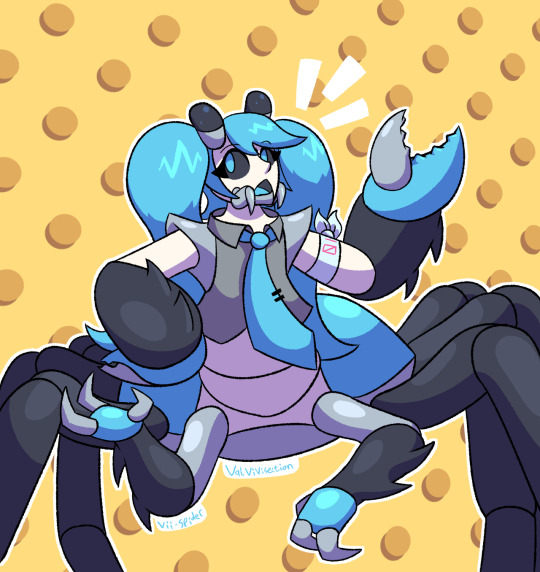
doing a mermay-style thing focused on bugs this may! so...
may-fly 2nd: hatsune michura
i'm the number one "crustaceans are bugs" proponent, so, what better way to start off may-fly than with a crab? more info n stuff under the cut!
michura is, obviously, based on a crab! she isn't any one specific species or clade, i just kinda took the general look of a crab and put miku into it. her name comes from miku (duh) and brachyura, which is the infraorder under decapods that all so-called "true crabs" fall into
the idea for this came from when, a couple days ago, i just Completely misinterpreted miku fanart i saw on twitter, and thought she had crab eyes. immediately fell in love with the idea after hastily scribbling this out on my phone at like 12:30 in the morning

so! i had to learn crab anatomy for this. and it is. fucked up.
first and foremost: understanding how the hell their faces work. surprisingly, it's not as complex as you'd think. those rectangular "jaws" you see?
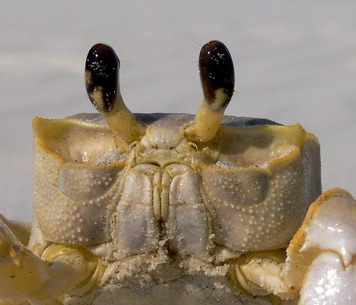
yeah, those are a pair of modified legs, neatly folded up, called maxillipeds. all the other mouthparts (including two other pairs of maxillipeds!) are tucked away behind those. so, thankfully, i only needed to give michura one pair of maxillipeds if i wanted to be particularly accurate!
something else i've learned that people tend to get wrong is how crab claws work. most people draw them opening from both sides, with a jagged and sometimes even hollow inside. but if you take a look at them on a real crab...
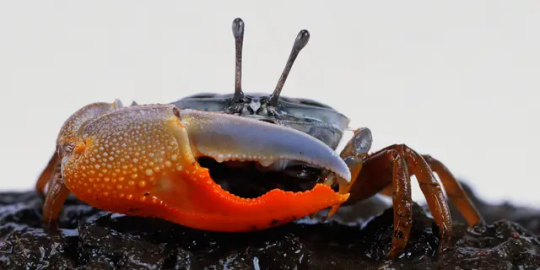
see that divide between the lower and upper "fingers?"
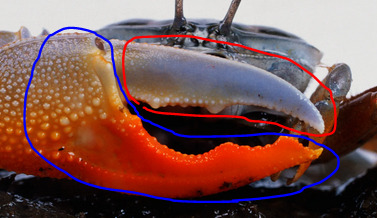
that's because only the top part of a crab's claw can move! the bottom part is just an extension of the "wrist" segment!
as for what's up with her arms... well, it's simple, really. i wanted to keep the claws because that's what crabs are known for, but i also wanted her to have more dexterous grasping appendages. originally both pairs of arms were on the torso, which was... more than a bit cluttered. i almost completely ditched the second pair, until-
"why not do two smaller front legs?"
in reference to how people give spider characters those weird stupid chelicera/palp/leg things. while i despise it on spiders... it's actually pretty in-line with how crabs are built, given their claws are just modified front legs! so, naturally, instead of putting the claws down there, i moved her hands down to where her frontmost legs would be, because i thought that would be kind of funny. i think it was a good call, honestly! since, i'd argue it's better for the more precise and dexterous grasping appendages to have the wider range of motion, and be able to reach the ground more easily, and i think it gives the design that "fucked up kind of weird" factor i really really like
uhhhh tldr, crab miku. i learned some stuff about crab anatomy in drawing her and now you have too
#my art#may-fly#hatsune miku#miku fanart#crab#crab girl#hatsune michura#cw bugs#sorta#crustaceans#brachyura#vocaloid#vocaloid fanart#btw may-fly isn't daily#i'm gonna try to do something once every ~4 or so days#since i have finals next week and don't want to be totally unable to draw when i “should”#so expect the next may-fly post around like#the 6th or so
66 notes
·
View notes
Note
Well since you reviewed Pinsir, how about Haracross too?

Heracross is the counterpoint to Pinsir, though ironically the two couldn't be more different design-wise. Pinsir is very much a monster that looks vaguely like a stag beetle, while Heracross is pretty straightforwardly a rhinoceros beetle (stag beetles and rhinoceros beetles being some of the most popular pairings in Japanese bug fights, which is what Pokemon is based off of). Sure, Heracross is bipedal and there are some anatomical differences here and there, but it's not quite as wildly different from the IRL insect compared to Pinsir.

Visually, Heracross is a fairly rare example of an almost completely monotone Pokemon, being a nice shade of blue with only its white claws and yellow eyes to break things up. The body has a plated look to match actual beetle exoskeletons, and includes details like the spikes on the forelegs that actual beetles have. I like Heracross' face in particular—the face is divided into its own section that looks around and under the eyes, creating a short of :3 mouth shape. It's both cute and a unique way to handle the tricky subject of how to stylize bug mouthparts for Pokemon in a way that isn't just humanoid. Overall, a very straightfoward design, but a pretty decent one.

The degree to which Heracross' design is straightforward is a bit of its time, so Mega Heracross adds a ton of detail, some of which works and some of which I think just clutters things. It also progresses the rhinoceros beetle idea by making it into a Hercules beetle specifically, one of the biggest beetles out there, as emphasized by the particular double horn shape.

I do really like the addition of the red bands around the body, which is now a slightly darker blue for higher contrast. I don't mind Heracross being monocolor, but the red bands add just the right pop of color without being too much. The progression of the theme and the overall changes to the body shape make it very distinct and give it a good sense of progression. There's also a few neat mechanical things in there, like the way it can pop open its arms to fire things like seeds

However, there's also some parts of the design that feel a bit overworked. For example, I don't get what that giant red splotch across the forehead is supposed to be; it's pretty distracting and really doesn't add anything to the design. (I also miss the :3 expression, but that's not the point.) Likewise, it has yellow on its back, which feels like too much color—yes, it looks like a Hercules beetle, but I feel like it gets that across perfectly well without the unnecessary color.

White it's less of a problem, I also don't love the vents on the stomach. It's probably supposed to look a bit mech-like because bugs are a big superhero thing in Japan, but I feel like this pushes it too much into looking mechanical instead of insect-like. I think if the vents were just changed to straight line divisions and the yellow elytra and red on the forehead were removed, you'd have a much more cohesive and less busy design.

As a whole, Heracross is a pretty straightforward but nicely designed rhinoceros beetle. Mega Heracross has the right idea, but has just a few too many things going on with it that bog down the design a bit.
46 notes
·
View notes
Text
Stamina
Downtime on the K’laxi Starbase, and Kelly and Evan wheel their stationary exercise bikes out into the common area and start a ride. If they're not going to be moving anyway, they might as well have a more interesting view than the wall of the exercise room. Before their commission, they both loved the outdoors, and found friendship in trying to keep their two wheeled skills.
The bikes large wheels that hum and whirr as they pedal. After a short warm up, they both get into the rhythm of motion, enjoying the feeling of their muscles being used. To help with overheating, Evan set up a fan to circulate air on them. Evan was used to short rides, but Kelly wanted him to build stamina. She was even working out how to connect a sensorium so they could ride "outside." For it to be worthwhile, she wanted a long ride, so she was trying to get him to be able to finish a century - a ride of one hundred miles (an obsolete form of measurement).
After a few moments, some K'laxi stop and watch them as they work out. Kelly and Evan, heads down as they pedal, don't seem to notice.
After half an hour or so of pedaling Evan lifted his head and looked at Kelly. “You know what I’m sick of?”
Kelly looked up from her bike. “The whole Deathworlder thing?”
Evan nodded emphatically. “Yes! I don’t think it’s fair that everyone says Earth is a Deathworld. It implies that we’re some kind of strange being. It’s othering!” Evan was gesturing with his water bottle as he spoke. The K'laxi watching were focused on the bottle being swung around, seemingly entranced by the droplets of water that Evan was flinging around.
Kelly leaned up off the handlebars, but kept pedaling. She started counting things on her fingers. “There’s plenty of other worlds that have storms, plenty of other sapient peoples that are strong, lots of places with large moons, plenty of other places like Earth.”
“Exactly! They are working so hard to fit us into a stereotype, and then they don’t have to learn about us as individuals.” Evan's water bottle was just leaking now, and droplets increased. Kelly blinked when drops hit her face. One of the K'laxi took a step back.
As they talked, the crowd grew. Deep in concentration on their ride, they didn't notice the attention that they have garnered. A Gren in the back gestured with his mouthparts, and two others joined him. A small group of Innari fluffed their feathers in agitation as they watched the humans continue to spin. Even a few humans stood on the sidelines of the crowd and grinned. They wanted to see what the others would do.
Evan and Kelly pedaled in silence for a while longer until Pen couldn't stand it any longer. His friends nudged him and whispered encouragement for him to finally speak up. “You realize you’re having this conversation, on a K’laxi Starbase, while pedaling your excise bicycles at-" He looked over at a readout on Kelly' bike "-180 watts for at least one standard hour now?”
Even looked surprised. “We’re doing a century!”
"That's when you ride continuously for 160 kilometers or so." Kelly sounded matter of fact as she reached down and took a sip from her own water bottle.
One of the Innari squawked, “You’re not even breathing heavy!” The others around them bobbed their heads in agreement.
Kelly looked over at the Innari who spoke up. When they locked eyes, the Innari looked down, their feathers flat, embarrassed. “You know what? They're right, Evan. Time to step it up.”
As Evan grinned and pedaled harder, he looked up and finally noticed the crowd that had gathered. There were maybe 10 or 12 people watching the two humans pedal without going anywhere. Some in the back were having quiet wagers about how long they could go on. A human was collecting the bets, not even trying to hide her smile.
The murmurs of the crowd finally got the better of Kelly. "Just what... are you all... doing here?" Kelly panted.
"Um.. just watching you pedal?" A young K'laxi in the front offered and took a nervous step back.
"I can see that, but why?"
"You're riding so much and you aren't even tired!" Another in the back added.
Nods and noises from assent from the crowd. They watched, fascinated as the human's active cooling started kicking in and they both developed a sheen of... liquid on their skin. They called it sweating. The K'laxi called it weird. The Innari called it disgusting.
A Gren on the side of the crowd joined in. "Yeah! How long can you go? I've got 30 stars with Mel'itar that says you can't go the full 160 kilometers without stopping."
A Sefigan near the front frowned and looked like he was having a conversation with his translator. “My translator says a century is 100, but you’re doing 160km?”
Evan sighed. “160 kilometers is 100 miles. That’s the century”
"What's a mile?" A K'laxi child from the crowd interrupted. Sounds of assent from the crowd.
"Old measurement. We don't use it anymore." Kelly finally started to sound like she was having difficultly speaking while she was exerting herself, a good while after Evan started breathing heavily.
The same Innari that spoke up earlier - Soft Autumn Breeze - stared at them out of one eye, and then the other. "You're pedaling the equivalent of one hundred sixty kilometers In one session?” It sounded like they were amazed in addition to being frustrated. Soft worked with Evan in the greenhouse, but had no idea he did... this in his spare time. It was perplexing. All this work and effort for no reason?
“Yeah” Kelly said between breaths “doesn’t count if you stop and take a break.”
Evan used his nearly empty water bottle to point at the Innari. "You're making it sound weird Soft, it's not weird."
"Evan, it is weird." Soft said, emphatically. "What you're doing is weird. You're... pretending to ride a two wheeled sapient powered conveyance on a starbase for an unreasonably long distance without stopping. If I tried that - even if you built one of those... things that fit my leg geometry, I'd collapse and die within two standard hours."
"Soft, I am riding it, it's not pretending." Evan countered.
"We're not going anywhere though, maybe that's what he means." Kelly said.
Evan shrugged. "Well, he should have said that."
By now, the crowd had started to argue about how long each species could last riding a bike. Most agreed that the humans would out-ride them full stop, but both the Gren and the Sefigans felt they could give a real challenge... for the first few hours at least. One of the humans in the crowd started taking measurements, and was designing a bike that could be printed for other species to ride. After a while a whole spin class was being set up.
Soft opened his mouth and clacked shut it again. His feathers fluttered in frustration, and he sighed dramatically. He turned around and walked away from the crowd. “Deathworlders” he muttered.
"Hey Soft, don't use that word, remember the training? The humans find it hurtful." Another Innari said as he walked by.
"Argh!" Soft stomped away as the noise of the crowd dissipated.
#writing#humans are deathworlders#humans are space orcs#sci fi writing#jpitha#humans and aliens#humans are space oddities#humans are space australians
275 notes
·
View notes
Note
non horny ask: what kinda irl snake would Yakumo be? venomous or non venomous?
my instinct says venomous purely because that opens up the fun possibility of magical side effects whenever yakumo bites someone (i want his venom to have a mild numbing property so he can bite me and i can finally get a decent night's sleep)
i'm openinmg up the search gtengine for this (HEY SNAKE FREAKS IN THE AUDIENCE!! IF YOU HAVE SUGGESTIONS THEN SHOW THE CLASS 👉👇👈👐)
(spoiler alert: i am no closer to an answer than when i started. we're just looking at snakes together)
flashback: i once pointed at western worm snake and laughed because BABY

but let's assign yaku a larger counterpart for when he's feeling big and brave i briefly considered the nonvenomous approach but i'm gonna joke that yakumo has a bigger oral fixation>>squeezing fixation on eiden so uh, this snake is all about the mouthparts i guess
i mean.. the snakes that constrict will inevitably hoRMPH(gulp) too so it would be reasonable to make yaku a nonvenomous squeezer. but. my bias says venom time, ,today
considering his ridic Great Serpent ancestry, he's probably gonna have a potent venom so let's look up Hella Dangerous Bitey Boys *typetypetypeclickclaxke*
side thought: are some species generally more aggressive than others? or does it vary moreso by individual? hmm. let's see if we can find a danger noodle that's reeaaaallllllly not into using its fangs as a first response
..... .......... i'm overwhelmed by choice again so i'm gonna start relying on aesthetics by which i mean altho i love defaulting to boas for their :3 face

i feel like yaku would be more of a streamlined snake skull like the neck isn't distinguished very well from the head... I wANT to see him as :3 snake puppy face but i also need him to have zero structure. absolute jello. no bones. skullless. just a *USES LINE TOOL*
wait. if i rely on Looks does that mean i can only choose IRL snakes that are black or subdued colours? because yaku doesn't want to be perceived, after all........
[eyes start to glaze over] -nondescript colouring -venomous (perhaps potently so) -not aggressive?? the type to strike ONCE , or wait-- is he more of a multi-striker.. fast? no... he seems like he'd be slow..if Dark Nova/Shadow Lineage is any indication..? slow OHKO heavy hitter? no, not "slow". HESITANT heavy hitter? ... -heat sensing organs? or just drawn to the heat? THE TYPE TO ONLY PREY ON OTHER VENOMOUS SNAKES--no no that's not right yaku will eat everything uhhhhhh
[SHAKES MY HEAD VIOLENTLY LIKE A WET DOG REBOOT]
call me basic but i like the look of mambas....
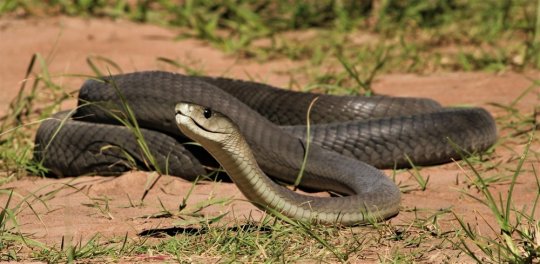
(sadly the black mamba doesn't have black scales but LOOK AT THAT MOUF!!!!!!!!!!)
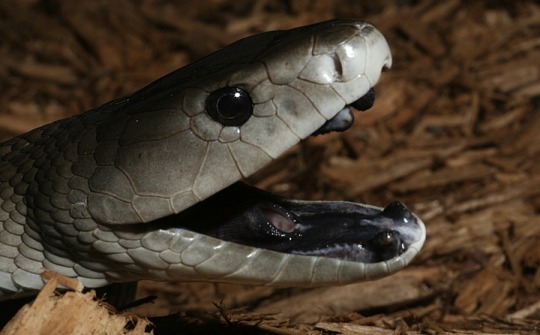
wait how about a snake that hangs out in east asia? MOUNTAIN KEELBACK????? lil diamonds all along the back .nice
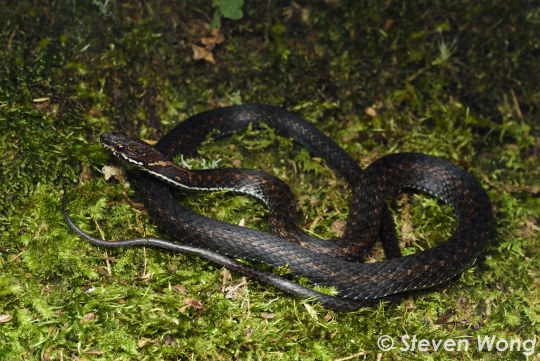
LOOK AT THE MASSIVE ORBS on *THIS* keelback.......
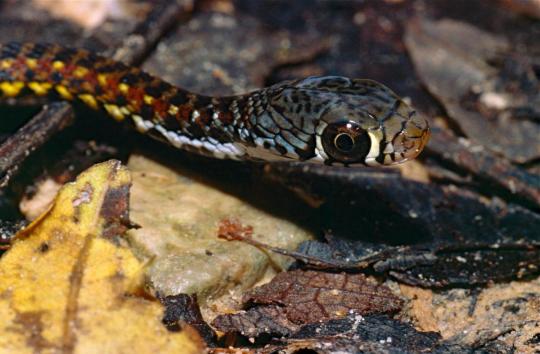
would he be arboreal like those funky vine snakes? mmm.., unlikely? i don't think yaku has shown much of a desire for heights... at least not yet (flashback to Puzzling Investigation Blade's impromptu takeoff)
what about a rattlesnake??? err... nah... yaku doesn't seem like much of a defensive butt wiggler....
Now i'm rethinking my entire instinct on VENOMOUS because ...Dark Nova 2 had yaku going snake-ish and eiden was ALL UP IN HIS fangs but he didn't feel any ill effects besides, you know, the physical obstacle of yaku shoving forked tongue down his throat-- EURYJK WHAT DO I DO . look at more cool snakes
OKAY BUT WHERE ARE THOSE SNAKES WITH THE PRETTY LOWER LASHES LIKE THE EYELASH VIPER, BUt LOWER lashes???
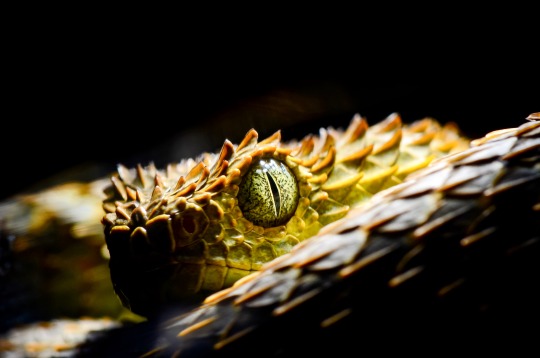
CAN I GET A LOOK AT ONE OF THOSE? do they exist? did i hallucinate the glorious snake lower lashes? do they belong to another reptile? boo.......
WWAIT NO, RIGHT, THE EYES, I SHOULD HAVE STARTED WITH THE EYES THAT'S AN EASY WAY TO NARROW DOWN A YAKUSNAKE

ok.ok. slit eyes. but a lil squiggly. thunderbolt eyes? the creative freedom of it all. let's go with slit eyes but wibbled by tears...
HOLD UP ! HIS EYES LOOK LIKE A TOKAY GECKO'S . IS YAKUMO ACTUALLY JUST A REALLY LONG GECKO?????

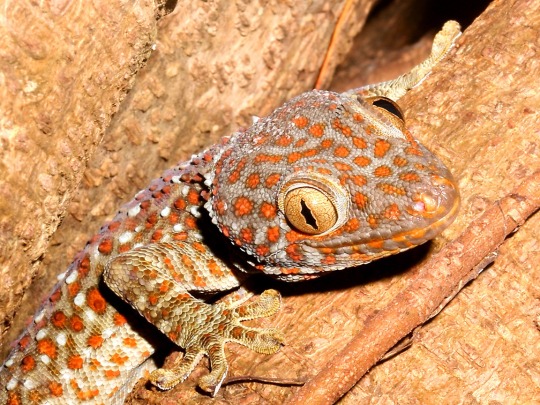
DESCENDANT OF THE LEGENDARY GREAT GECKO...........
#conclusion: i have no idea which snake he would resemble#every time i draw him in snake form it changes species anyway#can someone who can Make Decisions just.... make the choice#I AM NOT GOOD AT SELECTING THINGS#so in my universe i guess yaku is just EVERYsnake#i wonder if someone will walk in here and make a case for vipers. i mean. gaboon viper very cool but it doesn't scream yaku to me#if you're wondering if i was a snake freak before i got into nuca#not in particular. i just think animals are cool#but along comes yaku#and now i'm researching snake skull morphology at 3AM...........#nu carnival yakumo#feesh answer
24 notes
·
View notes
Text
Round 2 - Arthropoda - Branchiopoda
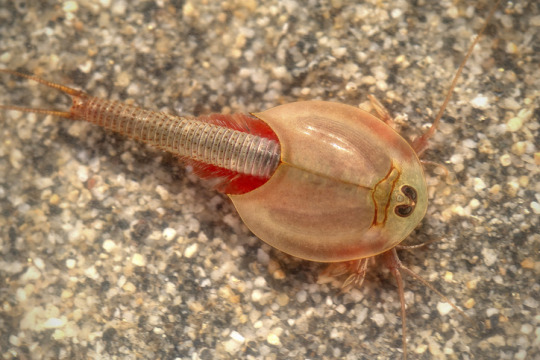

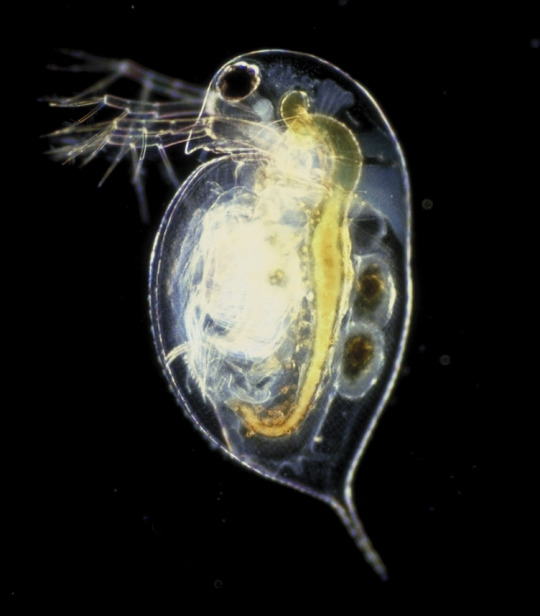

(Sources - 1, 2, 3, 4)
Branchiopoda is a class of small, mainly freshwater crustaceans that feed on plankton and detritus. They are comprised of 9 orders: Anostraca (“Fairy Shrimp”), Anomopoda (“Water Fleas”), Ctenopoda (also “Water Fleas”), Cyclestherida (“Clam Shrimp”), Laevicaudata (also “Clam Shrimp”), Spinicaudata (also “Clam Shrimp”), Haplopoda (“Predatory Water Fleas”), Onychopoda (“Water Fleas” again), and Notostraca (“Tadpole/Shield Shrimp”).
Branchiopods are found mainly in freshwater, including temporary pools and hypersaline lakes, and some in brackish water. Those that live in temporary pools are known for having eggs that can dry out for long periods of time and hatch once they are submerged in water, as an adaptation to drought. Only two families, one in Onychopoda and one in Ctenopoda, contain marine species. Most eat detritus or plankton, catching them in the setae on their appendages. Notostracans are opportunistic omnivores that will feed on algae, bacteria, other branchiopods like Anostracans, and even small fish.
Branchiopods are characterized by the presence of gills on many of the animals’ appendages, including the mouthparts. Most have compound eyes and a carapace. In the Clam Shrimp, the carapace prevents the use of the legs for swimming, so the antennae are used for locomotion instead, as they are in nauplius larvae.
The oldest known branchiopod was Rehbachiella kinnekullensis of the Upper Cambrian. Notostracans in particular have a good fossil record, with the oldest known species being Strudops goldenbergi from the Late Devonian. Notostracans are often described as “Living Fossils” due to their lack of major morphological change over 250 million years.
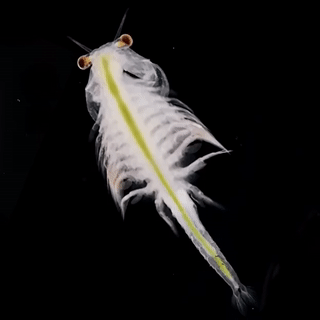
Propaganda under the cut:
Both Triops (a genus of Notostracan) and Artemia (a genus of Anostracan) make popular low maintenance aquarium pets, respectively called “Dinosaur Shrimp” and “Sea-monkeys” in the pet trade.
Triops longicaudatus helps control the West Nile virus, as they prey on Culex mosquito larvae.
In Japan, Triops cancriformis are used as biological pest control, kept in rice paddies to eat weeds.
Most branchiopods feed on small plankton and detritus, but some are large(r) predators, and Notostracans aren’t the only ones! The Giant Fairy Shrimp (Branchinecta gigas) can get up to 86 mm (3.4 in) long, lives in hypersaline lakes and rivers, and eats copepods and other branchiopods: mainly other fairy shrimp.
The genus Artemia, also known as Brine Shrimp, are commonly bred to feed fish and crustacean larvae, both in fish farms and in aquarium tanks, due to their ease of rearing, richness in nutrients, and tendency to be the preferred snack of small fish. Daphnia, a genus of Anomopod, are also often bred as fish food, as well as for amphibian larvae.
Artemia urmiana was once abundant in Lake Urmia of Iran, but drought has caused their population to drastically decline, leading to fears that they were nearly extinct. However, a second population has been discovered in Koyashskoye Salt Lake of Ukraine, giving hope for their recovery.
Scientists have taken the eggs of Artemia salina to outer space to test the impact of radiation on life. The brine shrimp eggs traveled on U.S. Biosatellite 2, Apollo 16, and Apollo 17 missions, and on the Russian Bion-3 (Cosmos 782), Bion-5 (Cosmos 1129), Foton 10, and Foton 11 flights. On Apollo 16 and Apollo 17, the cysts traveled to the Moon and back. Unfortunately, the results showed A. salina eggs are highly sensitive to cosmic radiation… 90% of the embryos died at different developmental stages.
Clam shrimp convergently evolved a shell similar to a bivalve. Both valves of the shell are held together by a strong closing muscle. The animals react to danger by contracting the muscle so that the valves close tightly and the crustacean floats motionlessly to the bottom of the water.
Daphnia are used in scientific studies as a model organism. Because they are nearly transparent, their internal organs are easy to study in live specimens. They are often used to test the effects of toxins and climate change, assisting with the assessment of ecological impacts caused by human disturbance.
One time, while looking at pond water under microscope, I saw a Chydorus sphaericus and squealed out loud cause it was so cute, and my professor made fun of me. But look at this. The Cheat lookin ass:

#round 2#animal polls#arthropoda#i love Triops and I always wanted some and even got as far as getting some eggs for my birthday as a kid and then just uh#never put them in water#i wonder if they would still hatch it’s been like 20 years…
35 notes
·
View notes
Text

@shiro-luxunder
It's not THAT bad but I also realize it's not as detailed as I thought

I just start eating recyclable shit like i'm going to die tomorrow
in the robot-me universe i had to take a position t a recycling plant in order to sustain my batshit diet, batshit diet being: just straight up plastic. And metal cans! (bonus: i feel like finalized djmm sona would have a tramp stamp commemorating it 💀)
How much plastic do you eat, unknowingly or otherwise? Chances are, a lot more than you should be, but not enough to create an entire house-sized carapace with it. Step 1 of robot puberty is to start EATING for i am a Growing Boy. Tangentially related, I have to go in the mines and start chowing down on precious metals for the exact same reason
At some point my skeleton dissolves
Significantly less scary than it sounds if you would believe me. It happens once my body looks like it completely abandoned my skeletal structure and I didn't notice it was happening until it occurred to me that I didn't have a skeleton anymore.
At some point i just vomit my own organs
Exactly as scary as it sounds. It didn't hurt but it stung my throat. But not all of them! Magical dust can go far but not all the way. Deep down I'm still your lovable flesh boy. Now I'm just full of wires and circuitry and gay shit like that - I still have my stomach, for example. Speaking of which
Eating Weird Shit 3: bacteria jamboree
thank god these were all means to an end because if I were to be organic after all this I think I would have released multiple plagues upon the world. Interestingly, during robot puberty, I became a ruminant, I have not one but multiple of my stomachs, for the flesh is not as weak as you might think, and can be a powerful tool for the machine. Basically I filled my stomachs full of a bunch of bacterias in order to facilitate all the fun things that robots do, like drinking oil and petrol, and also still eat food.
How did I do that? Ya boy was swimming around at the bottom of the mariana trench eating yummy microbes
I had a momentary crisis where I thought all that was left of my organic body was in my hands. And that I should feel shame for it and cover those things up
They aren't. My organic bits are all around my new robotic body. I just really didn't like having naked hands and my brain made shit up and gave me catholic guilt over it
I stopped being able to rotate my eyes and developed a fully rotatable neck like a cyborg owl
self explanatory. I started doing it at preachers on my campus calling everyone an abomination
The weird transitionary period of losing my legs and walking on my arms
Just really weird and awkward for everyone involved
The nightmare of my outer jaws flattening and turning into teethplates. The subsequent learning of semi-swallowing food like a snake.
i have regular jaws somewhere down my throat like a moray eel and I can eat regularly but I have to get food down there first. This was a courtesy on the magic dust on my part because we sat down and I was explained that I had to start swallowing food whole like a snake but I was able to negotiate that I can somewhat keep the same experience with food
actually, just all of my secret mouthparts
it's secret. can't tell you. you have to just find out
Figuring out my LED eyes
Did you know that your thoughts look a lot like AI-generated imagery? Now I do. It took me a long time to hone proper images down on those things
completely unrelated bonus but I got multiple massive grants to be allowed to studied and experimented on multiple occassions which I truly think is the only reason why i'm still here. I still feel like it wasn't enough.

15 notes
·
View notes
Note
what's up with bugs almost immediately giving up when theyre ensnared by something? sometimes i see an insect being attacked by another insect and even tho it looks like the prey could just shake off the assailant or just fly away, they just dont and appear to just let themselves be eaten with no struggle. am i looking at it in the wrong way?
couple things to consider here: a lot of predatory invertebrates have venom, so prey may be chemically paralyzed and unable to fight back. prey also may just be immobilized by the sheer strength of the predator—things like mantises and centipedes, although many don’t look strong to human eyes, are strong enough that sometimes prey items look like they’re just sitting there despite actually straining hard to break loose. many predators are just good at holding onto their prey—it’s important, after all. some may impale prey on mouthparts or raptorial arms, so prey can’t escape, and may combine this with holding prey away from the substrate so there isn’t anything to get a hold on.
otherwise, prey items usually give a pretty good fight, even in cases where the predator is venomous or strong! you are probably looking at things the wrong way if you don’t notice a struggle, or else got there too late to see it.
this Trachelas spider is quite a bruiser, with thick armor, eight powerful legs, and venomous fangs. yet a seemingly flimsy house centipede has the strength to drag it around, with prehensile legs wrapped around the spiders,’ and then delivers a dose of fast-acting venom after which the spider was completely paralyzed.
220 notes
·
View notes